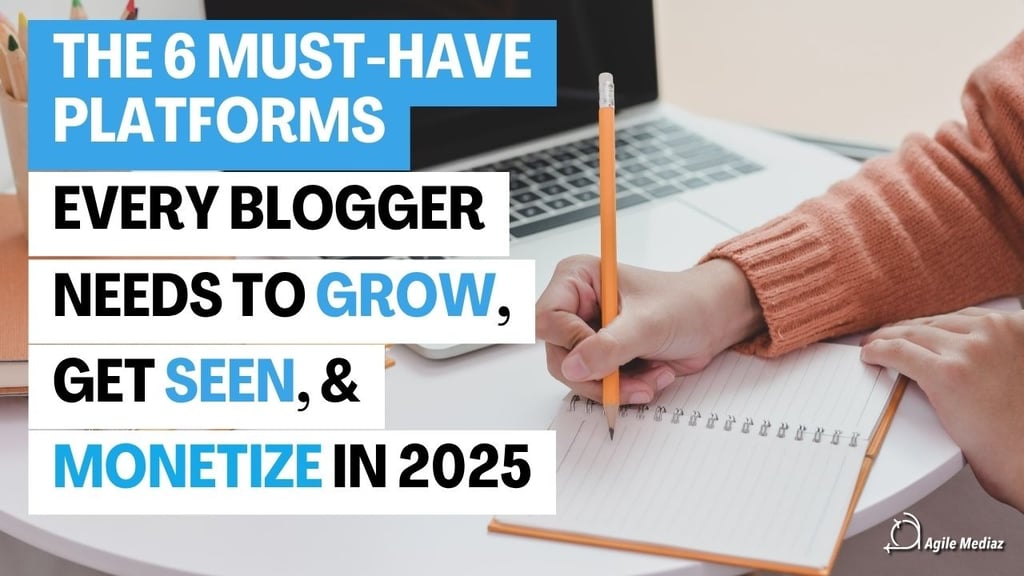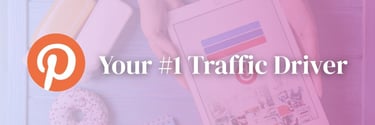The 6 Must-Have Platforms Every Blogger Needs to Grow, Get Seen, and Monetize in 2025
Discover the top 6 high-impact platforms every blogger should leverage to boost visibility, drive traffic, and grow their audience in 2025.
DIGITAL MARKETING TIPSONLINE BRANDINGCONTENT CREATIONDIGITAL MARKETINGMONETIZATIONBLOGGING
Agile Mediaz
1/5/20255 min read


So you’ve started a blog—now what?
Publishing your first blog post is a huge accomplishment, but it’s just the beginning of your online journey. The real magic happens in the distribution. In today’s crowded digital space, writing great content isn’t enough—you need to get it seen. That’s where strategic cross-platform promotion comes in. Whether you’re blogging to build a brand, grow a business, or monetize your passion, choosing the right platforms to share your work can amplify your impact, build community, and open up powerful income opportunities.
1. Pinterest – Your #1 Traffic Driver
Pinterest is not your average social media app—it functions like a visual search engine that keeps sending traffic long after your content is posted.
With millions of users actively searching for inspiration, tutorials, and ideas, Pinterest is a goldmine for evergreen content. Bloggers in lifestyle, DIY, wellness, food, fashion, and finance niches especially thrive here. Eye-catching vertical pins that link to your blog can drive thousands of monthly visitors with minimal ongoing effort.
Why it matters:
Pins last longer and gain traction over time—sometimes for years.
Users are ready to click, save, and shop—they’re not just scrolling for fun.
It’s free, and a few well-designed pins can build a traffic engine for your blog.
Pro Tip: Batch 5–10 branded pins per blog post using Canva and schedule them with Tailwind to save time.
2. Medium – Reach New Audiences and Build Authority
Medium is a distraction-free blogging platform with a built-in readership—and the potential for passive income.
Syndicating your blog posts (or writing exclusive content) on Medium puts your ideas in front of a larger audience without the need for paid ads or SEO hacks. It’s ideal for bloggers who write about entrepreneurship, self-improvement, tech, education, and lifestyle topics.
Why it matters:
Medium’s algorithms surface great content organically.
You can earn money via the Medium Partner Program based on reader engagement.
It’s an easy way to build backlinks and showcase your thought leadership.
Pro Tip: Republish existing blog posts with a note at the bottom linking to your original post to stay SEO-friendly.




3. LinkedIn – The Blogging Power Tool for Professionals
LinkedIn has evolved into a powerful platform for creators in the business, finance, leadership, and personal growth spaces.
Posting blog content, summaries, or even behind-the-scenes stories on LinkedIn positions you as a go-to voice in your industry. Your ideal readers—and potential clients, collaborators, or employers—are likely already there.
Why it matters:
Increases your authority and builds trust in professional circles.
Blog-based posts or newsletters on LinkedIn get strong engagement and visibility.
You can network and grow relationships that turn into real opportunities.
Pro Tip: Turn your blog into a LinkedIn carousel or newsletter and include a CTA back to your main blog.


4. Quora – Attract Targeted, Ready-to-Learn Readers
Quora is a goldmine for connecting with readers who are already searching for answers your blog can provide.
By answering questions related to your blog’s niche and linking to relevant articles, you can earn lasting SEO-friendly backlinks and drive highly interested readers straight to your content. This strategy works particularly well for bloggers in education, tech, personal finance, health, and productivity.
Why it matters:
Content lasts a long time and ranks well in Google.
Builds your credibility and positions you as an expert.
Drives targeted traffic—people who are already curious and engaged.
Pro Tip: Answer 2–3 niche-specific questions per week using snippets from your blog and add a link to the full article.


5. YouTube – Turn Blogs Into Visual Content That Converts
Video is no longer optional—it’s how today’s audiences learn, connect, and make buying decisions.
YouTube lets you repurpose blog posts into videos, voiceovers, tutorials, or explainers that expand your content’s reach. This is especially powerful because YouTube is the second-largest search engine after Google—and it’s directly integrated into Google search results.
Why it matters:
Increases your brand visibility and multiplies your content’s reach.
Builds deeper connections through visuals and personality.
Opens the door to monetization through ads, affiliate links, and sponsorships.
Pro Tips: Use free tools like Pictory, Lumen5, or Canva to turn blog outlines into short-form YouTube videos fast.


6. Threads or X (Twitter) – Build Micro-Authority & Real-Time Engagement
Micro-content builds macro influence—especially on fast-paced platforms like Threads and X (formerly Twitter).
These platforms are ideal for breaking your blog content down into short tips, one-liners, or quote-style posts that grab attention. By building trust in small doses, you create opportunities to share your full blog when people are already interested in what you have to say.
Why it matters:
Excellent for community-building and quick engagement.
Drives blog traffic via curiosity and link sharing.
Great place to network with other creators and small business owners.
Pro Tip: Repurpose blog headers or statistics into tweet threads with a final link to your full post.
You Don’t Need to Be Everywhere—Just Be Smart About It
You worked hard on your blog. Now make it work for you.
Spending just a few extra hours each week repurposing and sharing your content across the right platforms can lead to more readers, more authority, and more opportunities. Whether your goal is to grow your list, land paid partnerships, or turn your blog into a business—visibility is the bridge.
Start simple. Pick two platforms to focus on for the next 30 days. Track what works, tweak your strategy, and build from there. Blogging is a long game—and the right distribution strategy keeps your momentum going.
The content you created deserves to be seen. Now go put it where your audience already is.


Connect
Empowering small businesses through digital marketing solutions.
Explore
Innovate
contact@agilemediaz.net
© 2024. All rights reserved.

